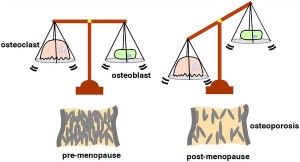<Title:> Mechanism Underlying Post-menopausal Osteoporosis: HIF1α is Required for Osteoclast Activation by Estrogen Deficiency
<Author(s):> Takeshi Miyamoto<Abstract:> The aging of the population worldwide has sharply increased the number of post-menopausal osteoporosis patients. Bone fragility caused by osteoporosis often results in fractures; therefore, controlling osteoporosis is crucial to prevent such injuries. To date, various drugs to treat osteoporosis have been developed and launched; however, the molecular mechanisms underlying post-menopausal osteoporosis have not been fully elucidated, and additional factors that could be targeted to treat patients remain to be characterized. Recently, hypoxia inducible factor 1 alpha (HIF1α) was identified as essential for osteoclast activation, an activity that promotes bone loss following menopausal estrogen deficiency. Although osteoclasts, which are located in hypoxic regions of the bone surface, express HIF1α mRNA, in pre-menopausal conditions the presence of estrogen decreases HIF1α protein levels in these cells. In menopausal conditions, however, estrogen deficiency allows HIF1α protein to accumulate in osteoclasts, leading to osteoclast activation and bone loss. Osteoclast-specific conditional HIF1α inactivation protects mice from estrogen deficiency-induced osteoclast activation and bone loss, as does systemic administration of a HIF1α inhibitor. Therefore, HIF1α represents a potential therapeutic target to prevent osteoclast activation and bone loss in post-menopausal patients.
<Keywords:> osteoclasts, postmenopausal osteoporosis, HIF1α, hypoxia, estrogen
<URL:> https://www.jstage.jst.go.jp/article/kjm/64/3/64_2015-0003-RE/_article


![Neurofibromatosis 1 (von Recklinghausen Disease) [Published online in advanced , by J-STAGE]](http://kjm.pupu.jp/blog/wp-content/uploads/2023/08/2023-0013-IR-100x100.jpg)
![Dementia care and research – What a difference a decade makes? [Published online Keio J Med, 68, 68-68, by J-STAGE]](http://kjm.pupu.jp/blog/wp-content/uploads/2019/09/68-004-ABST-100x100.jpg)
![Vertebrate Neural Stem Cells: Development, Plasticity, and Regeneration [Published online Keio J Med, 65, 1-15, by J-STAGE]](http://kjm.pupu.jp/blog/wp-content/uploads/2016/03/2015-0005-IR-100x100.jpg)
![Virus and Host Events in Squamous Carcinogenesis [Published online Keio J Med, 65, 78-78, by J-STAGE]](http://kjm.pupu.jp/blog/wp-content/uploads/2016/12/65-004-ABST-100x100.jpg)
![A Heart-shaped Sleeve Simplifies Intramedullary Tibial Nail Insertion when Using the Suprapatellar Approach [Published online Keio J Med, 67, 10-16, by J-STAGE]](http://kjm.pupu.jp/blog/wp-content/uploads/2018/03/2017-0001-OA-100x100.jpg)
![Vitamin D Deficiency with High Intact PTH Levels is More Common in Younger than in Older Women: A Study of Women Aged 39 64 Years [Published online Keio J Med, 65, 33-38, by J-STAGE]](http://kjm.pupu.jp/blog/wp-content/uploads/2016/06/2015-0010-OA-100x100.jpg)
![Physical Parameters, Use of Specific Medical Treatments, Nursing Levels, and Activities of Daily Living Are Potential Indicators for Forgoing Maintenance Hemodialysis [Published online in advanced , by J-STAGE]](http://kjm.pupu.jp/blog/wp-content/uploads/2019/05/2019-0001-OA-100x100.jpg)
![Human Amniotic Fluid Stem Cells: Therapeutic Potential for Perinatal Patients with Intractable Neurological Disease [Published online Keio J Med, 67, 57-66, by J-STAGE]](http://kjm.pupu.jp/blog/wp-content/uploads/2018/12/2017-0019-IR-100x100.jpg)
![Depression in Cancer Care [Published online in advanced , by J-STAGE]](http://kjm.pupu.jp/blog/wp-content/uploads/2017/10/2017-0010-IR-100x100.jpg)
![Mechanisms of iPS cell generation and beyond [Published online Keio J Med, 66, 14-14, by J-STAGE]](http://kjm.pupu.jp/blog/wp-content/uploads/2017/03/66-002-ABST-100x100.jpg)